
Waterloo is a London Underground station located beneath Waterloo National Rail station. As of 2022, it is the 2nd busiest station on the London Underground, with 68.72 million users. It is served by four lines: Bakerloo, Jubilee, Northern and Waterloo & City.

Bounds Green is a London Underground station, located at the junction of Bounds Green Road and Brownlow Road in Bounds Green in the London Borough of Haringey, North London. The station is on the Piccadilly line, between Wood Green and Arnos Grove stations, and is on the boundary between Zone 3 and Zone 4.

Finsbury Park is an intermodal interchange station in North London for London Underground, National Rail and London Buses services. The station is the third busiest Underground station outside Zone 1, with over 33 million passengers using the station in 2019.
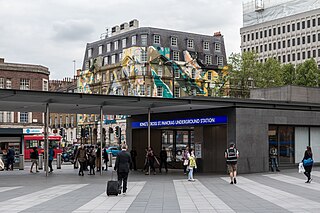
King's Cross St Pancras is a London Underground station on Euston Road in the Borough of Camden, Central London. It serves King's Cross and St Pancras main line stations in fare zone 1, and is an interchange between six Underground lines. The station was one of the first to open on the network. As of 2022, it is the most used station on the network for passenger entrances and exits combined.

Highbury & Islington is an interchange station in the London Borough of Islington, North London for London Underground, London Overground and National Rail services

Green Park is a London Underground station located on the edge of Green Park, with entrances on both sides of Piccadilly. The station is served by three lines: Jubilee, Piccadilly and Victoria. On the Jubilee line, it is between Bond Street and Westminster stations; on the Piccadilly line, it is between Hyde Park Corner and Piccadilly Circus stations and on the Victoria line, it is between Victoria and Oxford Circus stations. It is in fare zone 1.

St Paul's is a London Underground station located in the City of London financial district. The station, which takes its name from the nearby St Paul's Cathedral, is on the Central line, between Bank and Chancery Lane stations, and is in fare zone 1.

Covent Garden is a London Underground station serving Covent Garden and the surrounding area in the West End of London. It is on the Piccadilly line between Leicester Square and Holborn stations and is in Travelcard Zone 1. The station is at the corner of Long Acre and James Street and the street-level concourse is a Grade II listed building.

Gloucester Road is a London Underground station in Kensington, west London. The station entrance is located close to the junction of Gloucester Road and Cromwell Road. Close by are the Cromwell Hospital and Baden-Powell House.

Russell Square is a London Underground station opposite Russell Square on Bernard Street, Bloomsbury, in the London Borough of Camden. The station is on the Piccadilly line, between Holborn and King's Cross St Pancras and is in Travelcard Zone 1.
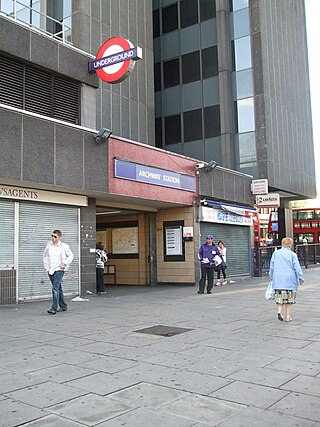
Archway is a London Underground station at the intersection of Holloway Road, Highgate Hill, Junction Road and Archway Road in Archway, north London, directly underneath the Vantage Point building. It is on the High Barnet branch of the Northern line, between Highgate and Tufnell Park stations, in Zones 2 and 3.
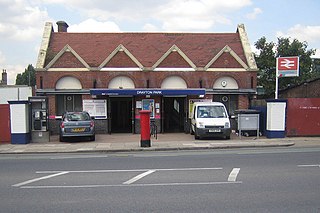
Drayton Park is a National Rail station in Highbury, in the London Borough of Islington. It is on the Northern City Line between Highbury & Islington and Finsbury Park stations, 2 miles 56 chains (4.3 km) down the line from Moorgate; it is in Travelcard Zone 2.

Arnos Grove is a London Underground station located in Arnos Grove in the London Borough of Enfield, London. It is on the Piccadilly line between Bounds Green and Southgate stations and is in Travelcard Zone 4. The station opened on 19 September 1932 as the most northerly station on the first section of the Piccadilly line extension from Finsbury Park to Cockfosters. It was the terminus of the line until services were further extended to Oakwood on 13 March 1933. When travelling from east of Barons Court and through Central London, Arnos Grove is the first surface station after the long tunnel section of the Piccadilly line. The station has four platforms which face three tracks.

Wood Green is a London Underground station. It is on the Piccadilly line between Turnpike Lane and Bounds Green stations and is in Travelcard Zone 3. It is located at the junction of High Road, Wood Green and Lordship Lane. It serves Wood Green Shopping City and the nearby Haringey Council administrative complex as well as a densely populated residential area. It is also the closest tube station to Alexandra Palace.
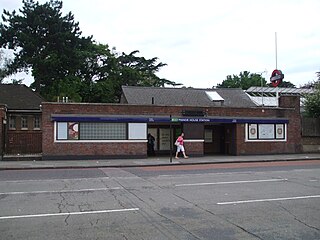
Manor House is a London Underground station. It is on the Piccadilly line between Finsbury Park and Turnpike Lane stations, and is on the boundary between Travelcard Zone 2 and Zone 3. It straddles the border between the London Boroughs of Hackney and Haringey, the postal address and three of the entrances being in the former, and one entrance in the latter.

Holloway Road is a station on the London Underground. It is on the Piccadilly line between Caledonian Road and Arsenal stations, and in Travelcard Zone 2. The station opened on 15 December 1906.

Mill Hill East is a London Underground station in Mill Hill in the London Borough of Barnet, north London. The station is the terminus and only station of a single-track branch of the Northern line from Finchley Central station and is in Travelcard Zone 4. It is the least used station on the Northern line with 1.41 million passengers in 2022.
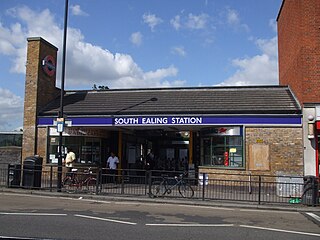
South Ealing tube station is a London Underground station in the London Borough of Ealing. The station is on the Heathrow Airport branch of the Piccadilly line, between Acton Town and Northfields stations. It is located on South Ealing Road and is in Travelcard Zone 3.

Caledonian Road is a station on the Piccadilly line of the London Underground, between King's Cross St. Pancras and Holloway Road, and in Travelcard Zone 2. It was opened on 15 December 1906 by the Great Northern, Piccadilly and Brompton Railway. The building was designed by Leslie Green.

Stamford Brook is a London Underground station on the eastern edge of Chiswick in west London. The station is served by the District line and is between Ravenscourt Park and Turnham Green stations. The main entrance is located on Goldhawk Road (A402) with a secondary entrance on Prebend Gardens. It is in Travelcard Zone 2.

























